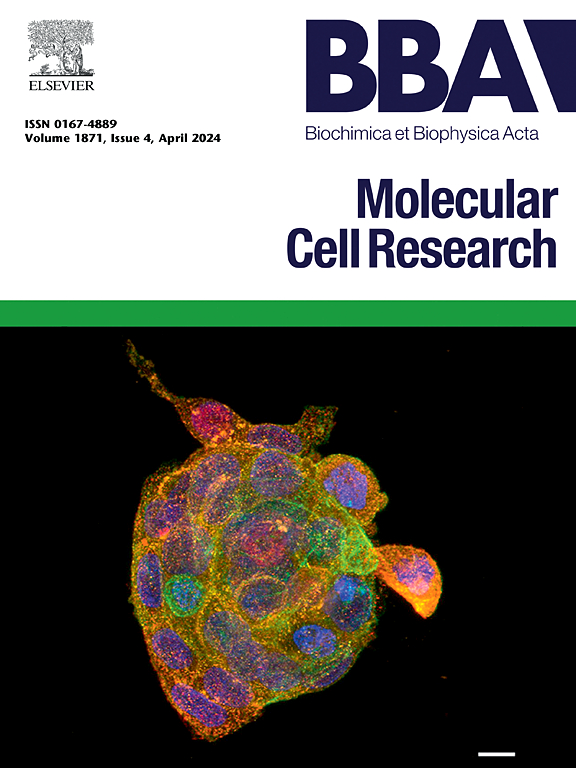Impaired insulin signaling and diet-induced type 3 diabetes pathophysiology increase amyloid β expression in the Drosophila model of Alzheimer's disease
IF 4.6
2区 生物学
Q1 BIOCHEMISTRY & MOLECULAR BIOLOGY
Biochimica et biophysica acta. Molecular cell research
Pub Date : 2024-11-07
DOI:10.1016/j.bbamcr.2024.119875
引用次数: 0
Abstract
Compelling evidence has strongly linked unregulated sugar levels to developing Alzheimer's disease, suggesting Alzheimer's to be ‘diabetes of the brain or ‘type 3 diabetes. Insulin resistance contributes to the pathogenesis of Alzheimer's disease due to uncontrolled and unchecked blood glucose, though the interrelatedness between Alzheimer's disease and type 2 diabetes is debatable. Here we describe the consequences of inducing type 3 diabetes by feeding Drosophila on a high sucrose diet, which effectively mimics the pathophysiology of diabetes. A high sucrose diet increases glycogen and lipid accumulation. Inducing type 3 diabetes worsened neurodegeneration and accelerated disease progression in Drosophila expressing the Alzheimer's Familial Arctic mutation. High sucrose milieu also negatively affected locomotor ability and reduced the lifespan in the Alzheimer's disease model of Drosophila. The results showed that creating diabetic conditions by using insulin receptor (InR) knockdown in the eyes of Drosophila led to a degenerative phenotype, indicating a genetic interaction between the insulin signaling pathway and Alzheimer's disease. The expression of PERK reflects disruption in the endoplasmic reticulum homeostasis due to amyloid-β (Aβ) under a high sucrose diet. These observations demonstrated an association between type 3 diabetes and Alzheimer's disease, and that a high sucrose environment has a degenerating effect on Alzheimer's disease condition.
胰岛素信号传导受损和饮食诱导的 3 型糖尿病病理生理学增加了阿尔茨海默病果蝇模型中淀粉样蛋白 β 的表达。
令人信服的证据表明,不受控制的血糖水平与阿尔茨海默氏症密切相关,阿尔茨海默氏症被认为是 "脑部糖尿病 "或 "3 型糖尿病"。胰岛素抵抗是阿尔茨海默病的发病机制之一,原因是血糖失控和不受控制,但阿尔茨海默病与 2 型糖尿病之间的相互关系尚存争议。在这里,我们描述了用高蔗糖饮食喂养果蝇诱发 3 型糖尿病的后果,这有效地模拟了糖尿病的病理生理学。高蔗糖饮食会增加糖原和脂质的积累。在表达阿尔茨海默氏症家族性北极突变的果蝇中,诱导 3 型糖尿病会加重神经退行性变,并加速疾病进展。高蔗糖环境也对果蝇的运动能力产生了负面影响,并缩短了阿尔茨海默氏症模型果蝇的寿命。研究结果表明,通过敲除果蝇眼睛中的胰岛素受体(InR)来创造糖尿病条件会导致退化表型,这表明胰岛素信号通路与阿尔茨海默病之间存在遗传相互作用。PERK的表达反映了在高蔗糖饮食下淀粉样β(Aβ)导致的内质网平衡紊乱。这些观察结果表明了3型糖尿病与阿尔茨海默病之间的联系,以及高蔗糖环境对阿尔茨海默病病情的退化作用。
本文章由计算机程序翻译,如有差异,请以英文原文为准。
求助全文
约1分钟内获得全文
求助全文
来源期刊
CiteScore
10.00
自引率
2.00%
发文量
151
审稿时长
44 days
期刊介绍:
BBA Molecular Cell Research focuses on understanding the mechanisms of cellular processes at the molecular level. These include aspects of cellular signaling, signal transduction, cell cycle, apoptosis, intracellular trafficking, secretory and endocytic pathways, biogenesis of cell organelles, cytoskeletal structures, cellular interactions, cell/tissue differentiation and cellular enzymology. Also included are studies at the interface between Cell Biology and Biophysics which apply for example novel imaging methods for characterizing cellular processes.

 求助内容:
求助内容: 应助结果提醒方式:
应助结果提醒方式:


